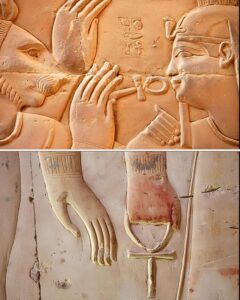Introduction to the Ankh and the Fascination with an Eternal Symbol
The Ankh, a unique and iconic symbol of ancient Egypt, dates back to around 4000 BC during Egypt’s pre-dynastic period. Known as the “key of life” or the “key of the Nile,” this emblem embodies profound concepts of life, rebirth, and immortality. With its design—a cross with a loop at the top—the Ankh is more than a symbol; it reflects the Egyptian philosophy of balance, harmony, and the divine power of eternal life.
Structure and Meaning of the Ankh
The shape of the Ankh—a circle atop a cross—carries layers of meaning. Many scholars believe the circle represents the rising sun on the horizon, symbolizing beginnings and rebirth. Additionally, this design is often understood as a harmonious union of male and female energies, representing the balance of opposing elements essential for the existence and sustainability of life.
Other theories suggest that the Ankh combines symbols of masculine (djed, representing stability) and feminine (was, representing power) qualities, reflecting Egyptian views on universal balance. This meaning makes the Ankh a representation of the life force, emphasizing that life exists not only in this world but continues in the world beyond.

The Ankh in Egyptian Culture and Religion
The Ankh was not limited to depictions on temple and tomb walls but appeared in many aspects of life. Ancient Egyptians often carved the symbol on temple and tomb walls to bless the deceased with life in the afterworld. Notably, the Ankh frequently appears in paintings and reliefs where gods offer the Ankh to pharaohs, symbolizing the bestowal of divine power and eternal life. This reinforces the sacred role of the pharaohs as a bridge between gods and humans and underscores the concept of immortality granted to these divine rulers.
The Ankh also served as a protective amulet believed to shield the wearer from harm and bring good fortune. In religious rituals, it affirmed the belief in immortality, emphasizing its importance in the Egyptian perception of existence beyond time.
The Ankh in Rituals and its Role in the Afterlife
The Ankh held a prominent role in ancient Egyptian funerary rites. Its presence in depictions of the afterlife shows the belief in the soul’s survival after death. Egyptians believed that when a soul passed through trials and was judged, the Ankh would be the symbol that bestowed eternal life in the new world. In royal tombs, the Ankh is often carved alongside gods, emphasizing its protective role and promise of eternal life for the soul of the deceased.
One of the most striking depictions of the Ankh is when gods present the symbol to pharaohs, symbolizing the gift of eternal life. This illustrates not only divine power but also the close relationship between the divine and royal authority in sustaining life and cosmic order.
The Mystery of the Ankh and Modern Discoveries
Although many theories surround the meaning of the Ankh, its origins and deeper layers of meaning remain a mystery. Modern archaeologists and historians continue to research the Ankh and the messages it may convey from ancient Egyptian civilization.
Today, the Ankh is more than just an archaeological symbol; it has become a popular symbol in culture and art, representing rebirth, eternity, and the interconnection of cultures. Many see the Ankh as a symbol of harmonious life, balance between body and soul, and a connection between past and present.

Conclusion: The Ankh—A Key to Understanding Ancient Egyptian Culture
The Ankh is a symbol rich in meaning, blending mythology, religion, and the Egyptian philosophy of life. As a “key of life,” the Ankh opens a door to understanding the profound worldview of a great civilization. Continuing to study the Ankh not only helps us uncover more about the past but also offers new perspectives on values of life, immortality, and the eternal connection of human spirituality.
Questions surrounding the Ankh remain, challenging and intriguing, inviting us to delve deeper into the spiritual canvas of ancient Egypt. Could this symbol reveal more about the beliefs and philosophy of the Egyptians? The journey into the Ankh may indeed still be unfolding, full of potential to unlock the secrets of a civilization rich in mystery and identity.
